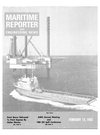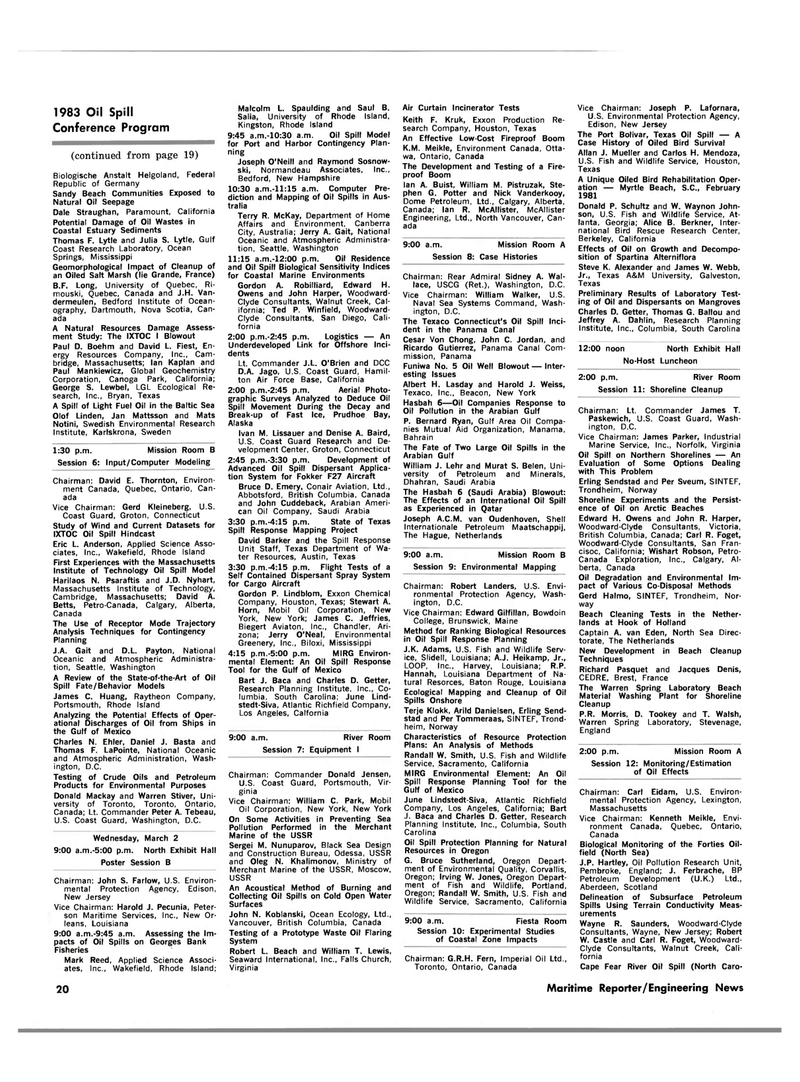
Page 16: of Maritime Reporter Magazine (February 15, 1983)
Read this page in Pdf, Flash or Html5 edition of February 15, 1983 Maritime Reporter Magazine
1983 Oil Spill
Conference Program (continued from page 19)
Biologische Anstalt Helgoland, Federal
Republic of Germany
Sandy Beach Communities Exposed to
Natural Oil Seepage
Dale Straughan, Paramount, California
Potential Damage of Oil Wastes in
Coastal Estuary Sediments
Thomas F. Lytle and Julia S. Lytle, Gulf
Coast Research Laboratory, Ocean
Springs, Mississippi
Geomorphological Impact of Cleanup of an Oiled Salt Marsh (lie Grande, France)
B.F. Long, University of Quebec, Ri- mouski, Quebec, Canada and J.H. Van- dermeulen, Bedford Institute of Ocean- ography, Dartmouth, Nova Scotia, Can- ada
A Natural Resources Damage Assess- ment Study: The IXTOC I Blowout
Paul D. Boehm and David L. Fiest, En- ergy Resources Company, Inc., Cam- bridge, Massachusetts; Ian Kaplan and
Paul Mankiewicz, Global Geochemistry
Corporation, Canoga Park, California;
George S. Lewbel, LGL Ecological Re- search, Inc., Bryan, Texas
A Spill of Light Fuel Oil in the Baltic Sea
Olof Linden, Jan Mattsson and Mats
Notini, Swedish Environmental Research
Institute, Karlskrona, Sweden 1:30 p.m. Mission Room B
Session 6: Input/Computer Modeling
Chairman: David E. Thornton, Environ- ment Canada, Quebec, Ontario, Can- ada
Vice Chairman: Gerd Kleineberg, U.S.
Coast Guard, Groton, Connecticut
Study of Wind and Current Datasets for
IXTOC Oil Spill Hindcast
Eric L. Anderson, Applied Science Asso- ciates, Inc., Wakefield, Rhode Island
First Experiences with the Massachusetts
Institute of Technology Oil Spill Model
Harilaos N. Psaraftis and J.D. Nyhart,
Massachusetts Institute of Technology,
Cambridge, Massachusetts; David A.
Betts, Petro-Canada, Calgary, Alberta,
Canada
The Use of Receptor Mode Trajectory
Analysis Techniques for Contingency
Planning
J.A. Gait and D.L. Payton, National
Oceanic and Atmospheric Administra- tion, Seattle, Washington
A Review of the State-of-the-Art of Oil
Spill Fate/Behavior Models
James C. Huang, Raytheon Company,
Portsmouth, Rhode Island
Analyzing the Potential Effects of Oper- ational Discharges of Oil from Ships in the Gulf of Mexico
Charles N. Ehler, Daniel J. Basta and
Thomas F. LaPointe, National Oceanic and Atmospheric Administration, Wash- ington, D.C.
Testing of Crude Oils and Petroleum
Products for Environmental Purposes
Donald Mackay and Warren Stiver, Uni- versity of Toronto, Toronto, Ontario,
Canada; Lt. Commander Peter A. Tebeau,
U.S. Coast Guard, Washington, D.C.
Wednesday, March 2 9:00 a.m.-5:00 p.m. North Exhibit Hall
Poster Session B
Chairman: John S. Farlow, U.S. Environ- mental Protection Agency, Edison,
New Jersey
Vice Chairman: Harold J. Pecunia, Peter- son Maritime Services, Inc., New Or- leans, Louisiana 9:00 a.m.-9:45 a.m. Assessing the Im- pacts of Oil Spills on Georges Bank
Fisheries
Mark Reed, Applied Science Associ- ates, Inc., Wakefield, Rhode Island;
Malcolm L. Spaulding and Saul B.
Salia, University of Rhode Island,
Kingston, Rhode Island 9:45 a.m.-10:30 a.m. Oil Spill Model for Port and Harbor Contingency Plan- ning
Joseph O'Neill and Raymond Sosnow- ski, Normandeau Associates, Inc.,
Bedford, New Hampshire 10:30 a.m.-11:15 a.m. Computer Pre- diction and Mapping of Oil Spills in Aus- tralia
Terry R. McKay, Department of Home
Affairs and Environment, Canberra
City, Australia; Jerry A. Gait, National
Oceanic and Atmospheric Administra- tion, Seattle, Washington 11:15 a.m.-12:00 p.m. Oil Residence and Oil Spill Biological Sensitivity Indices for Coastal Marine Environments
Gordon A. Robilliard, Edward H.
Owens and John Harper, Woodward-
Clyde Consultants, Walnut Creek, Cal- ifornia; Ted P. Winfield, Woodward-
Clyde Consultants, San Diego, Cali- fornia 2:00 p.m.-2:45 p.m. Logistics — An
Underdeveloped Link for Offshore Inci- dents
Lt. Commander J.L. O'Brien and DCC
D.A. Jago, U.S. Coast Guard, Hamil- ton Air Force Base, California 2:00 p.m.-2:45 p.m. Aerial Photo- graphic Surveys Analyzed to Deduce Oil
Spill Movement During the Decay and
Break-up of Fast Ice, Prudhoe Bay,
Alaska
Ivan M. Lissauer and Denise A. Baird,
U.S. Coast Guard Research and De- velopment Center, Groton, Connecticut 2:45 p.m.-3:30 p.m. Development of
Advanced Oil Spill Dispersant Applica- tion System for Fokker F27 Aircraft
Bruce D. Emery, Conair Aviation, Ltd.,
Abbotsford, British Columbia, Canada and John Cuddeback, Arabian Ameri- can Oil Company, Saudi Arabia 3:30 p.m.-4:15 p.m. State of Texas
Spill Response Mapping Project
David Barker and the Spill Response
Unit Staff, Texas Department of Wa- ter Resources, Austin, Texas 3:30 p.m.-4:15 p.m. Flight Tests of a
Self Contained Dispersant Spray System for Cargo Aircraft
Gordon P. Lindblom, Exxon Chemical
Company, Houston, Texas; Stewart A.
Horn, Mobil Oil Corporation, New
York, New York; James C. Jeffries,
Biegert Aviaton, Inc., Chandler, Ari- zona; Jerry O'Neal, Environmental
Greenery, Inc., Biloxi, Mississippi 4:15 p.m.-5:00 p.m. MIRG Environ- mental Element: An Oil Spill Response
Tool for the Gulf of Mexico
Bart J. Baca and Charles D. Getter,
Research Planning Institute, Inc., Co- lumbia, South Carolina; June Lind- stedt-Siva, Atlantic Richfield Company,
Los Angeles, Calfornia 9:00 a.m. River Room
Session 7: Equipment I
Chairman: Commander Donald Jensen,
U.S. Coast Guard, Portsmouth, Vir- ginia
Vice Chairman: William C. Park, Mobil
Oil Corporation, New York, New York
On Some Activities in Preventing Sea
Pollution Performed in the Merchant
Marine of the USSR
Sergei M. Nunuparov, Black Sea Design and Construction Bureau, Odessa, USSR and Oleg N. Khalimonov, Ministry of
Merchant Marine of the USSR, Moscow,
USSR
An Acoustical Method of Burning and
Collecting Oil Spills on Cold Open Water
Surfaces
John N. Koblanski, Ocean Ecology, Ltd.,
Vancouver, British Columbia, Canada
Testing of a Prototype Waste Oil Flaring
System
Robert L. Beach and William T. Lewis,
Seaward International, Inc., Falls Church,
Virginia
Air Curtain Incinerator Tests
Keith F. Kruk, Exxon Production Re- search Company, Houston, Texas
An Effective Low-Cost Fireproof Boom
K.M. Meikle, Environment Canada, Otta- wa, Ontario, Canada
The Development and Testing of a Fire- proof Boom
Ian A. Buist, William M. Pistruzak, Ste- phen G. Potter and Nick Vanderkooy,
Dome Petroleum, Ltd., Calgary, Alberta,
Canada; Ian R. McAllister, McAllister
Engineering, Ltd., North Vancouver, Can- ada 9:00 a.m. Mission Room A
Session 8: Case Histories
Chairman: Rear Admiral Sidney A. Wal- lace, USCG (Ret.), Washington, D.C.
Vice Chairman: William Walker, U.S.
Naval Sea Systems Command, Wash- ington, D.C.
The Texaco Connecticut's Oil Spill Inci- dent in the Panama Canal
Cesar Von Chong, John C. Jordan, and
Ricardo Gutierrez, Panama Canal Com- mission, Panama
Funiwa No. 5 Oil Well Blowout — Inter- esting Issues
Albert H. Lasday and Harold J. Weiss,
Texaco, Inc., Beacon, New York
Hasbah 6—Oil Companies Response to
Oil Pollution in the Arabian Gulf
P. Bernard Ryan, Gulf Area Oil Compa- nies Mutual Aid Organization, Manama,
Bahrain
The Fate of Two Large Oil Spills in the
Arabian Gulf
William J. Lehr and Murat S. Belen, Uni- versity of Petroleum and Minerals,
Dhahran, Saudi Arabia
The Hasbah 6 (Saudi Arabia) Blowout:
The Effects of an International Oil Spill as Experienced in Qatar
Joseph A.C.M. van Oudenhoven, Shell
Internationale Petroleum Maatschappij,
The Hague, Netherlands 9:00 a.m. Mission Room B
Session 9: Environmental Mapping
Chairman: Robert Landers, U.S. Envi- ronmental Protection Agency, Wash- ington, D.C.
Vice Chairman: Edward Gilfillan, Bowdoin
College, Brunswick, Maine
Method for Ranking Biological Resources in Oil Spill Response Planning
J.K. Adams, U.S. Fish and Wildlife Serv- ice, Slidell, Louisiana; A.J. Heikamp, Jr.,
LOOP, Inc., Harvey, Louisiana; R.P.
Hannah, Louisiana Department of Na- tural Resorces, Baton Rouge, Louisiana
Ecological Mapping and Cleanup of Oil
Spills Onshore
Terje Klokk, Arild Danielsen, Erling Send- stad and Per Tommeraas, SINTEF, Trond- heim, Norway
Characteristics of Resource Protection
Plans: An Analysis of Methods
Randall W. Smith, U.S. Fish and Wildlife
Service, Sacramento, California
MIRG Environmental Element: An Oil
Spill Response Planning Tool for the
Gulf of Mexico
June Lindstedt-Siva, Atlantic Richfield
Company, Los Angeles, California; Bart
J. Baca and Charles D. Getter, Research
Planning Institute, Inc., Columbia, South
Carolina
Oil Spill Protection Planning for Natural
Resources in Oregon
G. Bruce Sutherland, Oregon Depart- ment of Environmental Quality, Corvallis,
Oregon; Irving W. Jones, Oregon Depart- ment of Fish and Wildlife, Portland,
Oregon; Randall W. Smith, U.S. Fish and
Wildlife Service, Sacramento, California 9:00 a.m. Fiesta Room
Session 10: Experimental Studies of Coastal Zone Impacts
Chairman: G.R.H. Fern, Imperial Oil Ltd.,
Toronto, Ontario, Canada
Vice Chairman: Joseph P. Lafornara,
U.S. Environmental Protection Agency,
Edison, New Jersey
The Port Bolivar, Texas Oil Spill — A
Case History of Oiled Bird Survival
Allan J. Mueller and Carlos H. Mendoza,
U.S. Fish and Wildlife Service, Houston,
Texas
A Unique Oiled Bird Rehabilitation Oper- ation — Myrtle Beach, S.C., February 1981
Donald P. Schultz and W. Waynon John- son, U.S. Fish and Wildlife Service, At- lanta, Georgia; Alice B. Berkner, Inter- national Bird Rescue Research Center,
Berkeley, California
Effects of Oil on Growth and Decompo- sition of Spartina Alterniflora
Steve K. Alexander and James W. Webb,
Jr., Texas A&M University, Galveston,
Texas
Preliminary Results of Laboratory Test- ing of Oil and Dispersants on Mangroves
Charles D. Getter, Thomas G. Ballou and
Jeffrey A. Dahlin, Research Planning
Institute, Inc., Columbia, South Carolina 12:00 noon North Exhibit Hall
No-Host Luncheon 2:00 p.m. River Room
Session 11: Shoreline Cleanup
Chairman: Lt. Commander James T.
Paskewich, U.S. Coast Guard, Wash- ington, D.C.
Vice Chairman: James Parker, Industrial
Marine Service, Inc., Norfolk, Virginia
Oil Spill on Northern Shorelines — An
Evaluation of Some Options Dealing with This Problem
Erling Sendstad and Per Sveum, SINTEF,
Trondheim, Norway
Shoreline Experiments and the Persist- ence of Oil on Arctic Beaches
Edward H. Owens and John R. Harper,
Woodward-Clyde Consultants, Victoria,
British Columbia, Canada; Carl R. Foget,
Woodward-Clyde Consultants, San Fran- cisoc, California; Wishart Robson, Petro-
Canada Exploration, Inc., Calgary, Al- berta, Canada
Oil Degradation and Environmental Im- pact of Various Co-Disposal Methods
Gerd Halmo, SINTEF, Trondheim, Nor- way
Beach Cleaning Tests in the Nether- lands at Hook of Holland
Captain A. van Eden, North Sea Direc- torate, The Netherlands
New Development in Beach Cleanup
Techniques
Richard Pasquet and Jacques Denis,
CEDRE, Brest, France
The Warren Spring Laboratory Beach
Material Washing Plant for Shoreline
Cleanup
P.R. Morris, D. Tookey and T. Walsh,
Warren Spring Laboratory, Stevenage,
England 2:00 p.m. Mission Room A
Session 12: Monitoring/Estimation of Oil Effects
Chairman: Carl Eidam, U.S. Environ- mental Protection Agency, Lexington,
Massachusetts
Vice Chairman: Kenneth Meikle, Envi- ronment Canada, Quebec, Ontario,
Canada
Biological Monitoring of the Forties Oil- field (North Sea)
J.P. Hartley, Oil Pollution Research Unit,
Pembroke, England; J. Ferbrache, BP
Petroleum Development (U.K.) Ltd.,
Aberdeen, Scotland
Delineation of Subsurface Petroleum
Spills Using Terrain Conductivity Meas- urements
Wayne R. Saunders, Woodward-Clyde
Consultants, Wayne, New Jersey; Robert
W. Castle and Carl R. Foget, Woodward-
Clyde Consultants, Walnut Creek, Cali- fornia
Cape Fear River Oil Spill (North Caro- 20 Maritime Reporter/Engineering News

 15
15

 17
17
